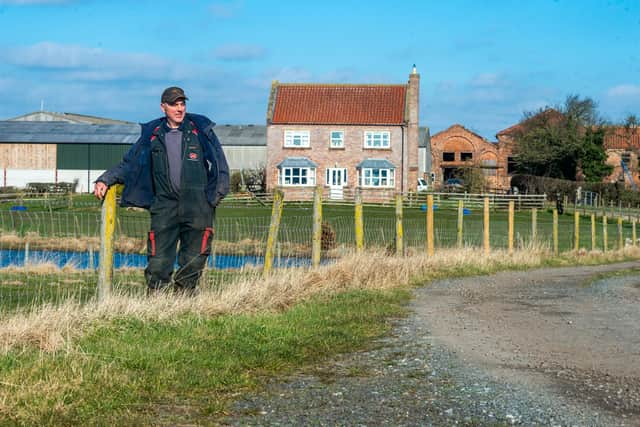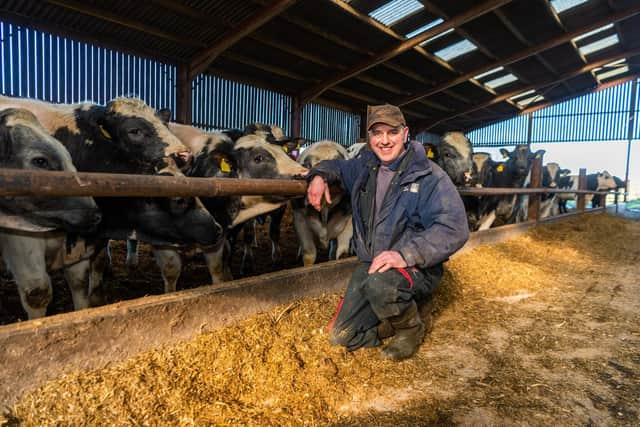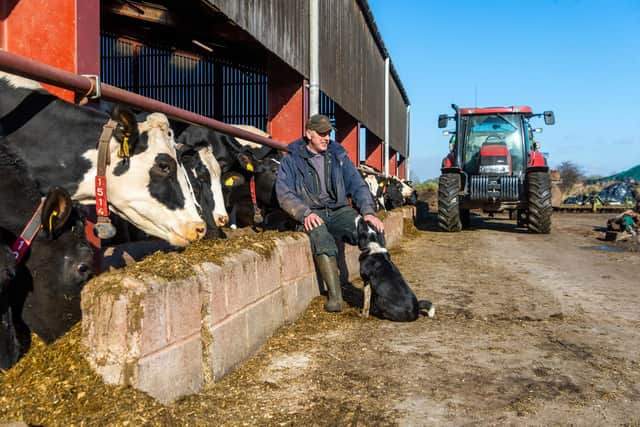Farm of the Week: Riding the dairy boom in Topcliffe as milk prices rise - but so do fertiliser costs
Richard Dunkley is a second generation dairy farmer and beef producer at the 400-acre West Lodge Farm, Topcliffe where he farms in a family partnership with his parents, John and Ellen, who started out in dairying 56 years ago at Carthorpe.
Richard said he’s as confident as he can be about the family’s future in dairy farming bearing in mind the hikes in production costs.
Advertisement
Hide AdAdvertisement
Hide Ad“Our milk price is as high as we’ve ever had it, but it needs to be as all of our costs have gone up this past year. I like to think that we are making a reasonable living for the work we do, but fertiliser costs are three times what they were last year.”


It has been a steady progression of the milk price, with a few seasonal dips along the way, that has brought dairying back from those dark days of six years ago when the sector was in turmoil with prices as low as 14ppl recorded and when the average dairy price was around 18ppl.
Richard said he recalls those days, but that an investment made shortly afterwards was proof of his family’s desire to carry on milking before the current boom.
“I have never thought of doing anything else. Our lowest point was when we were only getting around 17-18ppl, but since then we have seen the milk price gradually rise and particularly over recent months to where it is now. It was 37ppl in February and the average price across all dairy companies in January was just over 35ppl.
Advertisement
Hide AdAdvertisement
Hide Ad“But we were already investing in the future three and a half years ago when we switched over to robotic milking of our 150 pedigree Holstein cows. We now have three Lely A5 robots and were the first dairy farm in the north of England to have them. It was a case of either expanding the herd and having to take on more staff or go down the robotic route as my father was getting a bit older and we were wanting to at least make things like milking a little easier for us as a family.


“The cows got used to them very quickly and they now go to the robots on average around 3.3 times per day producing a herd average of 10,500 litres per lactation.”
Richard said that the farming system at Topcliffe has always revolved around dairying, producing their own herd replacements and the beef cattle from the dairy herd.
“We put around 50 of our herd to Holstein AI using sexed semen that works really well and provides us with heifers from which we will select the best for replacements for the herd. Our dairy cows average around four lactations, but we do have some cows, like every dairy farmer has, that go on for many years. We currently have one or two that are on their eighth and ninth lactations.


Advertisement
Hide AdAdvertisement
Hide Ad“We went on to sexed semen for the dairy replacements around a decade ago when it was just starting to gain a foothold.
“While the monthly milk cheque, now a bank transfer of course, is very important to our business we have also always run our beef cattle produced by 100 of our dairy cows right through to prime cattle. For a farm like ours it works well.
“Beef cattle produced from dairy herds is a by-product of the dairy sector and although there are a lot of dairy farms that will sell off their beef calves at maybe three to six weeks of age because they perhaps haven’t the shed space or time to keep them, we are geared up to take them right through.”
Richard uses AI from Belgian Blue beef cattle mostly with a sprinkling of Limousin and Aberdeen Angus.
Advertisement
Hide AdAdvertisement
Hide Ad“We just want to produce a good beast that sells well in the auction mart at Thirsk. The Belgian Blue crossed with the Holstein produces a decent animal that butchers want. We use the Aberdeen Angus AI at times for assisting any heifers for ease of first-time calving.
“For the past 18 months we’ve had a good run for finished beasts at Thirsk. We had some go just a few weeks ago that each made around £1,500. It has always proved a highly sustainable activity here at Topcliffe.”
Richard said his beef heifers, dry cows and replacement dairy heifers graze in the summer months but that the milkers stay inside.
“The milkers enjoy a more constant ration, they are comfortable and tend to milk better. We feed them silage, maize, a protein blend, molasses and in the robot a little dairy cake.”
Advertisement
Hide AdAdvertisement
Hide AdThe farmland that is part-tenanted and part-owned encompasses around 150 acres of cereals this year with 100 acres of winter wheat varieties Skyscraper and Insitor and Richard said it usually averages around four tonnes per acre. Contractors are drafted in for the heavier arable tasks such as drilling and combining.
Richard’s wife Jenny is also from dairy farming stock, her father being Frank Wood from Cowesby, and he and Jenny came together the traditional farming way through the Young Farmers Club network.
“I was a member of Bedale YFC but our daughters Emma and Alice are both involved with Thirsk YFC. They are also in the Holstein Club.”
Richard said that although West Lodge’s cows are pedigree Holsteins he has not shown them, but his daughters were on the verge of doing so last year.
Advertisement
Hide AdAdvertisement
Hide Ad“We were going to show them at a Holstein competition at York livestock market but unfortunately when it came to show day we went down with Covid. Hopefully this year we will have better luck”
Richard said that the family dairy farm is probably just under the average size for a dairy operation in the UK today but that he is happy with where they are.
“I’m a workaholic and have just joined a new stewardship scheme that as well as undertaking work on hedges and bird cover strips should make up a little from losing the single farm payment. Losing it will make things a little harder, but I think we can cope with it.”
